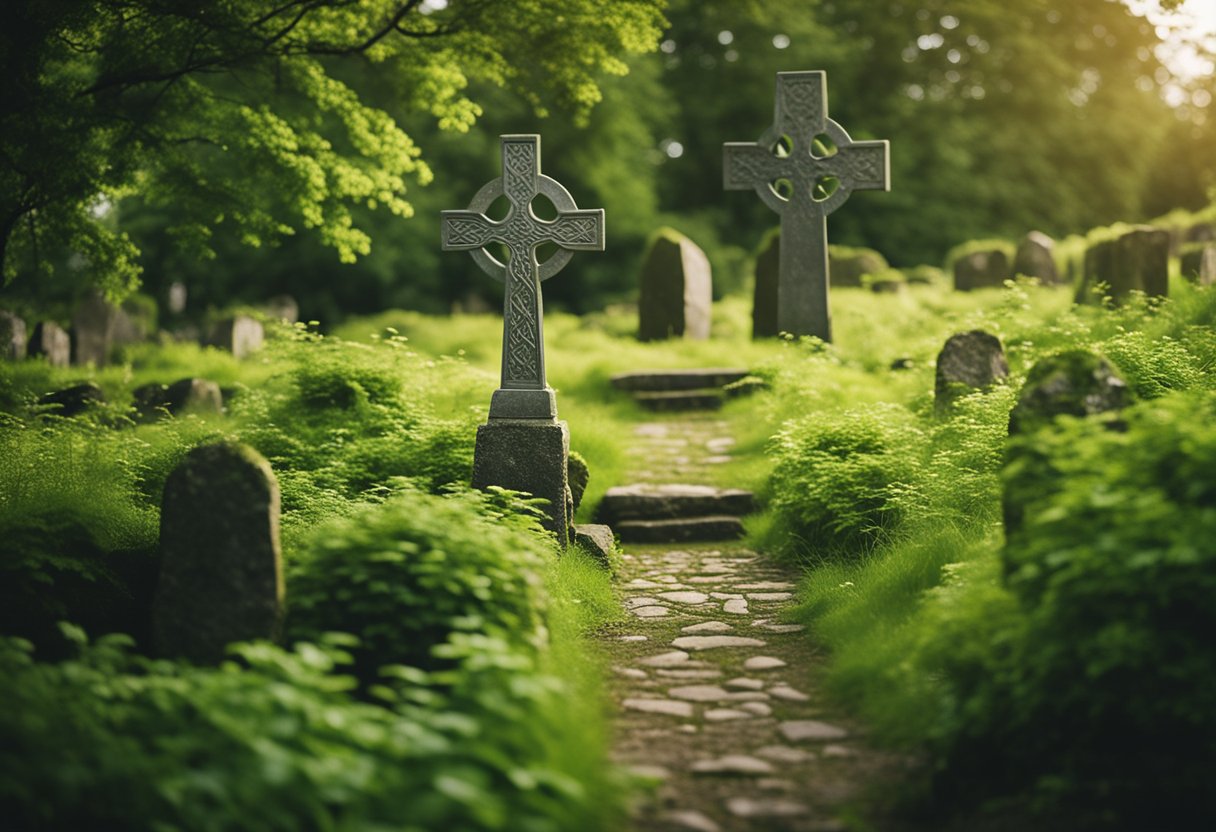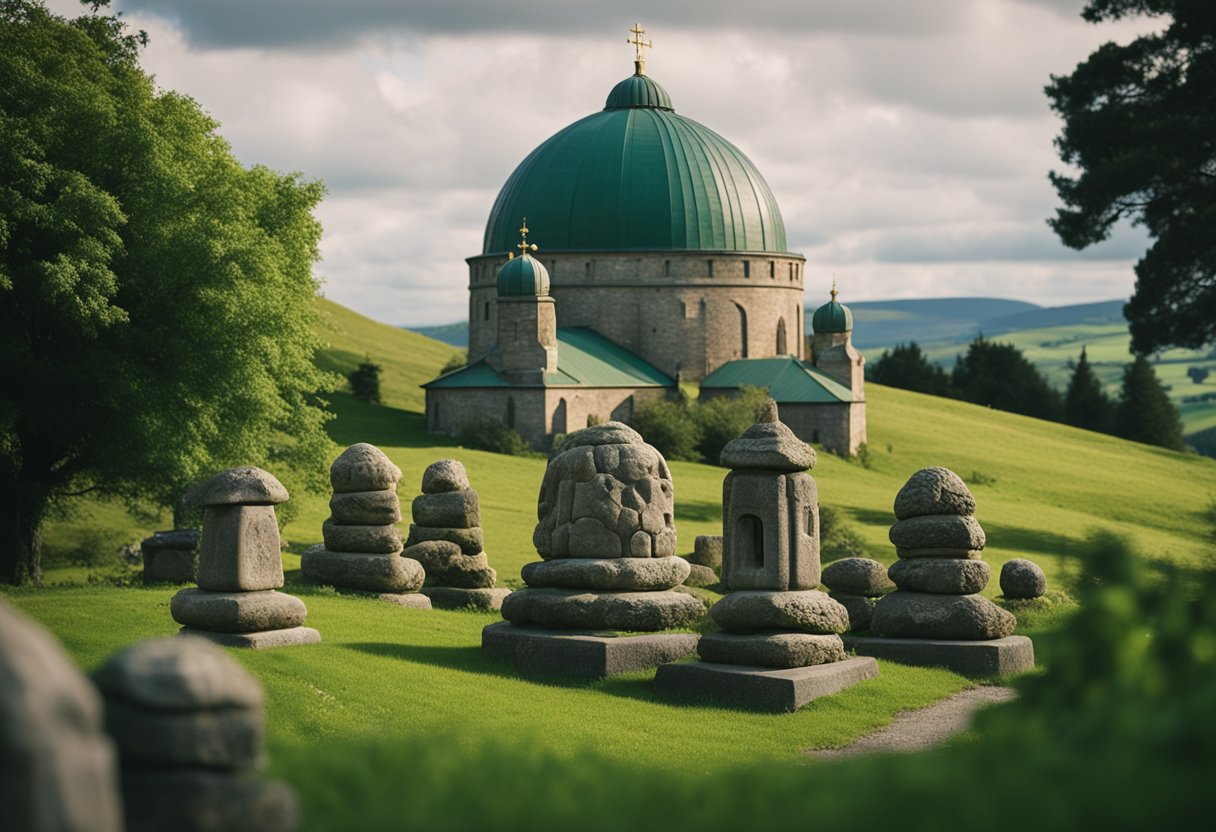The Influence of Irish Monasticism on Continental Learning and Religious Practice

Updated On: April 23, 2024 by Yasmin Elwan
The influence of Irish monasticism played a pivotal role in shaping European culture during the early Middle Ages; a period often referred to as the Dark Ages. During this time, monasteries served as beacon points for learning and culture, preserving not only religious texts but also invaluable knowledge from classical antiquity. The monastic movement in Ireland grew independently of Rome, and its unique form of Christianity flourished within the structures of Celtic society. The impact of Irish monastic practice extended far beyond Ireland’s shores, influencing the spiritual, intellectual, and artistic landscapes of continental Europe.

The monastic schools and scriptoria of Ireland became centres of excellence in education and literary production, earning Ireland the title of the “Island of Saints and Scholars.” The dedication of Irish monks to the transcription of manuscripts ensured the preservation and dissemination of classical and religious knowledge. Additionally, the distinct architectural style of Irish monastic buildings and their elaborately decorated artefacts, such as the Book of Kells, reflect significant artistic achievements. Through their missionary work and the establishment of monasteries abroad, Irish monks facilitated cultural exchange and contributed substantially to the Christianisation of Europe.
Foundations of Irish Monasticism
We must appreciate Irish monasticism as a significant facet of the country’s history, profoundly influencing European culture. The ascetic movement rooted in Ireland not only fortified the faith across a continent but also preserved and transmitted classical learning during periods of uncertainty and change.
Origins and Development
Irish monasticism began to flourish after the arrival of St. Patrick in the 5th century. He was instrumental in spreading Christianity and establishing monasteries across Ireland, serving as centres of religious life and learning. Unlike their continental counterparts, Irish monasteries were typically situated in remote areas, emphasising solitude and a connection with nature.
Monasteries quickly became hubs of intellectual activity and were pivotal in the cultural and spiritual development of Ireland. They were self-sufficient, focusing on agriculture, craftsmanship, and education, with a particular emphasis on scriptoria for manuscript copying.
Key Figures and Saints
Several key figures stand out in the narrative of Irish monasticism:
- St. Patrick, best remembered for converting Ireland to Christianity, played a fundamental role in the foundation of Irish monasteries.
- St. Brigid of Kildare is renowned for her generosity and the establishment of the Kildare monastery, a centre for religion and learning.
- St. Columba was an example of Irish monasticism’s reach beyond its own shores. His influence spread to Scotland after founding the monastery at Iona, which became an important centre for evangelism.
Monasticism in Ireland, punctuated by the efforts of these saints, laid the groundwork for a scholarly tradition that would preserve knowledge through Europe’s darkest periods. The monastic scriptoria were essential in copying not only religious texts but also the works of classical antiquity, thus safeguarding the intellectual heritage of Europe.
Monastic Practices and Daily Life
In this section, we explore the rigorous ascetic lifestyles of Irish monks, their balance of prayer and work, and the role of monastic education in European culture.
Ascetic Lifestyles
Irish monks were known for their ascetic practices, embodying simplicity and self-denial to enhance their spiritual journeys. They chose remote locations, like the stunning sea islands off the West coast, to establish their monasteries, living in humble stone beehive huts that encouraged focus and discipline. Meals were modest, often reflecting the self-sufficient nature of monastic life.
Prayer and Work
Monastic life was structured around the Latin motto ‘Ora et Labora’, meaning Prayer and Work. Monks committed to several hours of prayer, with frequent services at the altar throughout the day and night. Their labour was both manual, tending to farmlands and scriptoriums, and spiritual, through the study and copying of scriptures in languages like Latin and Greek, which were essential to their daily routine.
Monastic Education
At the heart of Irish monasticism was education. Monastic schools established by these communities became centres for scholarly pursuits. The study was integral, spanning from religious texts to classical works, ensuring the preservation and transmission of knowledge through the Dark Ages. Monks played a pivotal role in teaching, making significant contributions to the intellectual heritage of Europe.
In adhering to a life of asceticism, prayer, work, and study, Irish monastics significantly shaped European culture, embedding a legacy of learning and spiritual discipline that has resonated through the centuries.
Architectural Contributions

Our monastic heritage has significantly influenced European architecture, particularly through the design of our monastic settlements and our iconic round towers.
Design of Monastic Settlements
We developed distinct monastic settlements that were characterised by their unique layout and structure. These settlements typically included a group of buildings such as a main church or chapel, domestic quarters for the monks, and often a scriptorium where manuscripts were copied and illuminated. For example, the monastery of Clonard, founded by Saint Finnian in the 6th century, became a significant centre of religion, learning, and craftsmanship, which influenced monastic culture across Ireland.
Another exemplary site is the Monastery of Kildare, founded by Saint Brigid in the 5th century. It became one of the most prestigious monastic cities in the country. The architecture here showcases how Irish monastic settlements integrated with the local environment, often using available resources to create both functional and enduring constructions.
Iconic Round Towers
Our round towers stand as a testament to the distinct architectural style developed during the early medieval period. These towers, typically found in association with Irish monastic sites, served multiple functions: as bell towers, places of refuge, and as landmarks signifying the presence of a Christian monastery. They are constructed from local stone, and their remarkable height, which could extend up to 40 metres, signalled the monastery’s presence from afar.
For instance, the round tower in Kildare is one of the most impressive and well-preserved examples. It demonstrates our aptitude for stone construction and the importance of these towers in monastic life. Our round towers remain one of the most enduring symbols of Irish ecclesiastical architecture and have influenced stone tower construction across Europe.
Our monastic architectural legacy, from the comprehensive design of settlements to the construction of high-round towers, reflects our rich history and has undeniably contributed to European architectural practices.
Literature and Learning
The Irish monks were instrumental in the promotion of literacy and the preservation of classical texts throughout medieval Europe. Their monastic schools and scriptoriums became pivotal in cultivating and disseminating knowledge across the continent.
Scriptoriums and Manuscripts
In the heart of Irish monasteries, scriptoriums were bustling hubs of activity where monks meticulously copied texts. These manuscripts were not only religious texts but also works of literature, including those by classical authors such as Ovid, Virgil, and Cicero. The preservation and production of such manuscripts aided in safeguarding the intellectual heritage of ancient Rome and Greece during a period when much of Europe was engulfed in turmoil and change.
- Ovid’s Metamorphoses
- Virgil’s Aeneid
- Cicero’s treatises on rhetoric and philosophy
Each meticulously copied work was an act of learning in itself, a way of engaging intimately with the content. Indeed, these transcriptions served as critical vectors for cultural and intellectual continuity.
Spreading of Classical Knowledge
Irish monks did not sequester their valuable manuscripts; they played an active role in the spreading of classical knowledge. It was common for them to travel widely, founding monasteries and schools which acted as new nodes in the network of learning. Through these travels, the literary and philosophical works of antiquity were introduced to new audiences, fostering a Renaissance of classical learning in regions beyond Ireland’s shores.
- Classics were taught to succeeding generations.
- Manuscripts were shared with continental monasteries.
This dissemination was crucial to the Carolingian Renaissance, a period where the thirst for learning and literature saw a revival, largely due to the scholarly foundations laid by Irish monasticism. Through their dedication, Irish monks were key to the continuity and expansion of educational and literary traditions in medieval Europe.
Artistic Influence of Irish Monasticism
Irish monasticism has bequeathed a unique and profound legacy on the artistic landscape of Europe, particularly through the intricate visual arts and the remarkable influence they exerted across the continent.
Monastic Visual Arts
We encounter the zenith of Irish monastic artistry in stunningly illuminated manuscripts like the world-renowned Book of Kells. This masterpiece epitomises the intricate beauty and complexity synonymous with Irish monastic art. Its vivid colours, detailed iconography, and precise calligraphy are indicative of the exceptional skill and aesthetic sensibilities of Irish monks, influencing the monastic visual arts across Europe.
The Influence on European Art
The artistic flair of Irish monasticism travelled beyond the shores of Ireland, as the trademark high crosses and remarkable stone carvings became sources of inspiration throughout Europe. The influence on European art can be readily seen; the cross of the Scriptures at Clonmacnoise, for instance, served as a template for similar creations across the continent. The spread of these motifs is a testament to not only the beauty but also the cultural exchange fostered by Irish monasticism.
Cultural and Religious Expansion
In the historical narrative of Europe, Irish monasticism plays a pivotal role, acting as a conduit for cultural and religious expansion during the Middle Ages. Our focus is on how the Irish monastic movement spurred this growth through widespread missions and natural integration into European society.
Irish Diaspora and Missions
The Irish diaspora had a profound influence on the religious and cultural life of early medieval Europe. Monks from Ireland, truly embodying the spirit of their faith, embarked on peregrinatio, or missions, to spread Christianity far beyond their shores. The Island of Iona became an illustrious centre for scholarship and missionary work, sending out monks to found significant monasteries across Europe.
One such figure was Saint Columban, who journeyed across the continent and established monasteries at Luxeuil and Bobbio, among other places. His work not only shared religious beliefs but also Irish culture, including art and learning. These missions laid the foundations for conversion efforts throughout the continent, and Irish monasticism’s reach extends to the influential monastery at Lindisfarne, which was founded by Irish monk Saint Aidan and became an epicentre for the Christianisation of England.
Integration with European Society
Our monks’ integration with European society was not limited to the realm of faith. Their establishments became centres of learning, cultural exchange, and preservation, engaging in the copying and creation of manuscripts, which would preserve much of Europe’s Classical heritage during turbulent times. This blend of spiritual devotion and scholarly pursuit solidified Irish monks’ reputation, proving indispensable for Europe’s intellectual revival.
For instance, Saint Gall, an Irish missionary in the region that would become Switzerland, catalysed an artistic and educational movement that greatly influenced the spread of monasticism. Gall’s legacy is celebrated as a cornerstone of European culture, reflecting the tangible impact these monastic foundations had on European society.
Through missions and societal contributions, Irish monks played a fundamental role in shaping the cultural and religious landscapes of Europe, leaving a legacy that resonates in European culture to this day.
Influence on European Monasticism
Irish monasticism played a vital role in shaping the structures and spiritual practices across European monasteries.
Spread of Monastic Practices
Irish monastics are credited with the dissemination of unique ascetic practices and the concept of private confession to continental Europe. The Irish penchant for isolated hermitages inspired similar movements in European monasticism, particularly the emphasis on solitary prayer and self-denial. The model of Irish monasteries, often comprising clusters of individual cells, influenced the architectural layout of many European monastic communities.
Formation of Monastic Networks
The Irish monastic framework established extensive networks that fostered academic and cultural exchange across Europe. Monks from Ireland, revered for their scholarship and piety, traversed Europe, founding monasteries that became hubs of learning and evangelisation. Notable among them was St. Columbanus, whose foundations in France and Italy sparked the growth of monastic networks into which the Benedictine Rule, systematised by St. Benedict, later became integrated.
These networks, supported by figures like Charlemagne, who recognised their importance for ecclesiastical reform and education, underpinned the Carolingian Renaissance. Monastic schools emerged from this milieu, contributing to the preservation and transmission of classical and religious texts, thus influencing the intellectual life of Europe. The role of abbots and bishops was enhanced within these networks, often holding significant ecclesiastical power alongside their spiritual responsibilities.
Political and Social Impact

The spread of Irish monasticism across Europe not only fostered religious devotion but also had profound political and social ramifications. Irish monasteries became hubs of learning and culture, influencing the social fabric of the regions they touched. These institutions also engaged with secular authorities, affecting the governance and political landscape of the time.
The Monastery as a Social Centre
Monasteries served as centres of social life in medieval Europe. Within their confines, monks and abbots played vital roles in the community by providing education, dispensing charity, and supporting the local economy. They operated as self-sufficient entities with vast lands that required management and labour. The scriptoriums became focal points for the preservation and transmission of knowledge, with Irish monks meticulously copying texts that would have otherwise been lost.
Interactions with the Secular Rulers
The relationship between the church and state was intricately woven, with monasteries often interacting directly with secular rulers. Irish monks, at times, served as advisors to kings and were instrumental in the spread of Christian doctrines that influenced state policies. Noteworthy in this context was the role of Charlemagne, who allied with the church to unify and rule his empire. Consequently, abbots held not only spiritual sway but also temporal influence, often acting as intermediaries between the bishop and the state. Their role in politics was pivotal in shaping the development and stability of various European regions.
Survival and Adaptation
The influence of Irish monasticism on European culture is a complex tale of resilience and change. Through the challenges of Viking raids and the shifts of the Middle Ages, Irish monks played a pivotal role in the preservation and evolution of Christian knowledge and cultural practices.
Response to Viking Raids
The advent of Viking raids in the 8th century presented a dire threat to the monastic establishments across Ireland. Our manuscripts, high crosses, and ecclesiastical treasures were under constant attack. However, Irish monasteries demonstrated remarkable endurance. Some communities relocated to isolated areas such as Skellig Michael, a rocky outpost off the Irish coast, which served as a refuge. The choice of such remote locations reflects the strategic adaptation of these religious communities to preserve their way of life and the manuscripts that were central to Christendom at the time.
Transformation During the Middle Ages
During the Middle Ages, Irish monasticism underwent transformations that had a lasting impact on European culture. Monasteries became centres of learning and hubs for cultural exchange, enduring even as the forces of the Reformation and Renaissance began to sweep across Europe. The Irish monastic tradition adapted to the changing times, fostering an environment that valued both religious devotion and scholarly pursuits.
This blend of faith and intellect allowed for the survival of classical texts and the nurturing of new European intellectual movements. Our monasteries no longer just preserved ancient texts but actively contributed to cultural life, engaging in the scriptorium with a playfulness that passed on knowledge through generations. The transition from cloistered sanctuaries to influential cultural institutions illustrates the dynamic adaptation of Irish monasticism throughout the ages.
Legacy of Irish Monasticism
Irish monastics played a pivotal role in preserving and fostering the growth of learning across Western Europe during a period when much of the continent was experiencing significant upheaval. Their contributions firmly established the foundations for cultural and intellectual development in Europe.
Enduring Influences on Western Culture
Irish monasticism significantly shaped Western culture, particularly through its contributions to learning and scholarship. Monasteries became centres of education, preserving classical texts and promoting literacy. Monks meticulously copied manuscripts, ensuring that the theological and philosophical insights of the past were not lost. Additionally, the Irish tradition of pilgrimage and peregrinatio led to the spread of ideas as monks travelled and established new monastic communities throughout Europe, influencing local practices and integrating with different cultures.
- Preservation of texts and learning: Their manuscript work played a vital role in the history of Western Europe.
- Establishment of educational centres: Monasteries doubled as schools and repositories of knowledge.
These scholarly endeavours cultivated an environment in which intellectual pursuits flourished, profoundly impacting the cultural and educational systems in Europe.
Irish Monasticism in Modern Times
In modern times, the influence of Irish monasticism persists. It can be seen in contemporary educational structures and cultural commemorations that trace their origins back to monastic practices. Irish monasteries’ tradition of learning is often cited as a precursor to the European university system. Scholarship and study developed within these monastic communities laid the groundwork for more formal institutions that arose in subsequent centuries.
- Influence on educational systems: Links to current educational practices.
- Cultural commemorations: Events and recognitions stemming from monastic heritage.
Our appreciation of Irish contributions to Western intellectual history continues to grow as scholars delve deeper into the past and acknowledge the richness of the legacy handed down to us. Irish monks were no less than cultural architects of the medieval period, and their legacy indeed reaches into our present-day understanding of Western heritage.
Frequently Asked Questions
Irish monasticism played a significant role in shaping European culture, particularly through the preservation of knowledge and the spread of Christianity. Let’s explore some of the most frequently asked questions to understand its impact.
How did Irish monasticism contribute to the preservation and dissemination of classical knowledge in Europe?
Irish monasteries were essential in the preservation of European classical knowledge. During the early medieval period, many classical texts would have been lost if not for the meticulous work of Irish monks who dedicated themselves to the copying of manuscripts. These texts included works from Latin and Greek culture, which the monks both copied and studied, becoming instrumental in keeping classical learning alive.
In what ways did the work of Irish monks and their scriptoria influence the development of European manuscript culture?
The scriptoria in Irish monasteries were bustling centres where monks diligently produced beautifully illuminated manuscripts. This work greatly influenced the development of manuscript culture across Europe, setting high standards for artistic and scholarly craftsmanship. The Irish developed unique scripts, such as the Insular script, which became widely adopted throughout medieval Europe.
What role did Irish monastic centres play in the spread of Christianity throughout the continent?
Irish monastic centres were not just secluded retreats; they were active in missionary work and played a pivotal role in spreading Christianity throughout Europe. Irish monks established monasteries across the continent, bringing Christianity to remote regions and laying the groundwork for the Christianisation of Europe.
Can the missionary activities of Irish monks be seen as a catalyst for cultural exchange in medieval Europe?
Absolutely, the missionary activities of Irish monks served as a catalyst for cultural exchange during the medieval period. Their travels and establishment of monasteries facilitated the sharing of religious practices, intellectual ideas, and art, contributing to a rich tapestry of cultural intercourse between Ireland and the rest of Europe.
What was the impact of the monastic tradition on the educational landscape of early medieval Europe?
The monastic tradition in Ireland played a crucial role in shaping the educational landscape of early medieval Europe. Monasteries often ran schools that were among the earliest formal educational institutions in Europe, teaching not only religious doctrine but also secular subjects, hence nurturing the intellectual life of the continent.
How did the practices and spiritual traditions of Irish monasteries shape religious life in Europe?
The practices and spiritual traditions of Irish monasteries had a profound influence on religious life in Europe. The approach to monastic life, with its distinct emphasis on asceticism, prayer, and manual labour, set examples for religious communities. Irish monasticism, with its distinctive balance of contemplation and work, inspired the formation of new monastic orders and spiritual practices throughout Europe.






